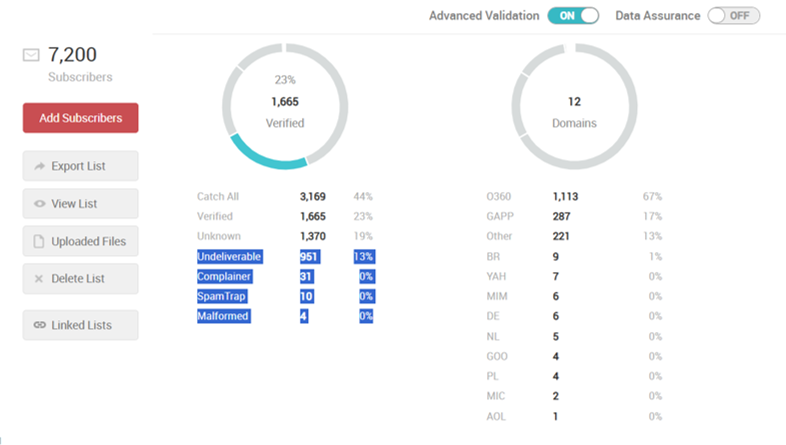At Lead Generation Institute, we know that email marketing success hinges on one crucial factor: the quality of your email list.
Email verification is the cornerstone of maintaining a healthy, high-performing email database. It’s not just about having a long list of contacts; it’s about having a list of real, engaged recipients.
In this post, we’ll explore why email verification is essential for your marketing efforts and how it can significantly boost your campaign performance.
Why Clean Email Lists Matter
The Hidden Costs of Dirty Data
Email lists deteriorate by approximately 22.5% annually (according to HubSpot research). This statistic underscores the importance of regular list maintenance. Neglecting email hygiene leads to a domino effect of issues that harm marketing efforts and impact the bottom line.
Sender Reputation: Your Digital Credit Score
Sender reputation functions as a credit score for email marketers; Internet Service Providers (ISPs) use this score to determine email placement-inbox or spam folder. A poor sender reputation can devastate deliverability rates, rendering carefully crafted campaigns ineffective.

To maintain an excellent reputation, try to keep bounce rates below 2% and spam complaints under 0.1%. These benchmarks are essential for staying in the good graces of ISPs and ensuring messages reach intended recipients.
Bounce Rates and Spam Complaints: Silent Killers
High bounce rates do more than annoy; they raise red flags for email providers. Each bounced email erodes sender reputation. Spam complaints can inflict even more damage. Just five complaints per 5,000 emails sent can trigger ISP alarms.
To combat these issues, implement a double opt-in process for new subscribers and clean your list regularly to remove inactive or invalid addresses. This proactive approach will significantly reduce both bounce rates and spam complaints.
Deliverability: The Ultimate Goal
Clean lists increase the likelihood of bypassing spam filters and landing directly in subscribers’ inboxes. This increased visibility translates to higher open rates, click-through rates, and ultimately, better ROI for email marketing campaigns.
A small, engaged list will always outperform a large, unengaged one. Prioritize quality over quantity, and watch your email marketing metrics soar.
The mechanics of email verification play a vital role in maintaining list hygiene and achieving email marketing success. Let’s explore how this process works in the next section.
How Email Verification Works
Email verification is a process that helps verify if there is an actual user on the receiving end of the email address. This process involves several key components that work together to improve marketing outcomes.
Syntax and Format Checks
The first step in email verification is syntax and format checking. This step examines the structure of an email address to ensure it adheres to standard conventions. A valid email must contain an @ symbol, have no spaces, and include a domain extension like .com or .org.

Modern verification tools can catch common typos and formatting errors that users often make. These tools identify issues such as missing dots, extra spaces, or invalid characters. Catching these errors early prevents simple mistakes from turning into costly bounces or undelivered messages.
Domain and MX Record Verification
After confirming the basic format, the next step verifies the domain and its associated Mail Exchanger (MX) records. This process checks if the domain part of the email address (everything after the @ symbol) actually exists and can receive emails.
Verification tools query the Domain Name System (DNS) to confirm the presence of valid MX records. These records indicate which mail servers handle email for that domain. If no MX records are found, it’s a clear sign that the email address is invalid or the domain is not set up for email communication.
Mailbox Existence Checks
The final and most critical step verifies the existence of the specific mailbox. This process involves communicating with the mail server to check if the user’s mailbox actually exists without sending an email.
Mailbox existence checks can be performed using two methods:
- SMTP connection: The verification tool initiates a connection to the mail server using the Simple Mail Transfer Protocol (SMTP). It simulates sending an email but stops short of actually delivering it.
- VRFY command: Some servers allow the use of the VRFY command to verify if a recipient exists.
It’s important to note that while these checks are highly effective, they’re not foolproof. Some mail servers are configured to reject existence checks to prevent spammers from harvesting valid email addresses. In such cases, the verification process may return an “accept-all” or “catch-all” result, indicating that further verification might be necessary.
Note: Catch-Alls or Accept-All emails happen when the mail server says as long as the domain is correct i.e., Microsoft.com, we will accept the email. This doesn’t mean the email is valid.
We have been testing a new solution called Bounceban, which reports that they can verify catch-all emails. They do this by first determining what type of email account this email is, i.e., Office 365, Google, or General Internet. Then, they enter the email as the user to see if that email exists. If the platform accepts the email and requests a password to access that account, it’s safe to assume this is an active email account.
The combination of these verification methods (syntax checks, domain verification, and mailbox existence checks) provides the most accurate results. A robust email verification process significantly reduces bounce rates, improves deliverability, and enhances the effectiveness of email marketing campaigns.
Now that we understand how email verification works, let’s explore the tangible benefits it brings to businesses and their marketing efforts.
How Email Verification Boosts Marketing Success
Email verification transforms email campaigns from mediocre to exceptional. This practice yields substantial benefits that directly impact your bottom line.
Supercharging ROI and Engagement
Email verification increases the return on investment (ROI) of your email marketing efforts. It ensures that your messages reach real, active inboxes, connecting you with interested recipients. This targeted approach leads to higher open rates, click-through rates, and conversions.

A study found that marketers who regularly clean their email lists can improve their email deliverability rates. A good email deliverability rate should be at least 85 percent, with 98 to 99 percent being ideal. Any deliverability rate below 70 percent is considered poor.
Slashing Costs and Boosting Efficiency
Many email service providers charge based on the number of subscribers or emails sent. Removing invalid or inactive addresses through verification can significantly reduce these costs. For instance, if 20% of your 100,000 email list is invalid (a common scenario), you could save up to 20% on your email marketing platform fees by removing these addresses.
Focusing your efforts on verified emails means your team spends less time managing bouncebacks and more time on strategic initiatives. This efficiency gain can lead to substantial cost savings in terms of labor and resources.
Enhancing Personalization and Segmentation
Email verification doesn’t just clean your list; it enriches your data. Many verification services provide additional information about email addresses, such as whether they’re personal or business accounts, their geolocation, or even associated social media profiles.
This enhanced data allows for more sophisticated segmentation and personalization strategies. You could create targeted campaigns for business email users versus personal email users, or tailor content based on geographic location. Personalized emails can significantly improve transaction rates, making this benefit particularly valuable.
Improving Data Quality
Email verification improves the overall quality of your customer data. It helps identify and remove outdated or incorrect information, ensuring that your marketing efforts are based on accurate and up-to-date data.
High-quality data leads to better decision-making, more effective targeting, and improved customer insights. It also reduces the risk of sending emails to the wrong person or company, which could potentially damage your brand reputation.
Protecting Sender Reputation
Your sender reputation is a critical factor in email deliverability. Email verification helps protect and improve this reputation by reducing bounce rates and spam complaints. A good sender reputation ensures that your emails are more likely to land in the inbox rather than the spam folder.
Maintaining a clean email list through regular verification is an essential practice for any business serious about email marketing. It not only improves campaign performance but also protects your brand and enhances your overall marketing strategy.
Final Thoughts
Email verification stands as a cornerstone of successful email marketing. It ensures accuracy, improves deliverability, and enhances ROI. Businesses that prioritize email verification will achieve cleaner databases, more targeted campaigns, and better results.

We recommend integrating verification tools into sign-up forms and cleaning existing email lists every four to six months. Remember that B2B data degrades anywhere from .05% to 2% a week, depending on the economy.
Double opt-in methods can further reduce spam complaints and confirm subscriber intent. These practices will optimize your email marketing efforts and drive revenue growth.
Lead Generation Institute offers consulting services and training programs to help implement robust email verification strategies. Our knowledge-sharing community and tools can support you in optimizing campaigns for better outcomes. Contact us today to elevate your email marketing to new heights.




